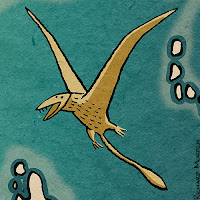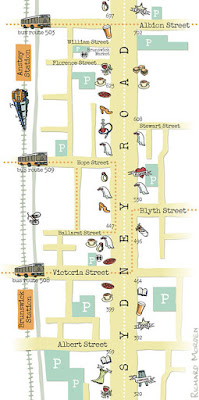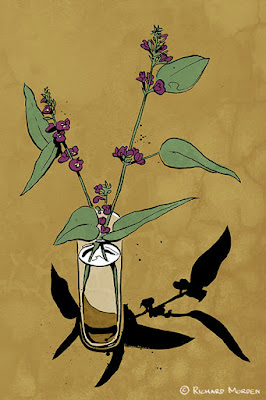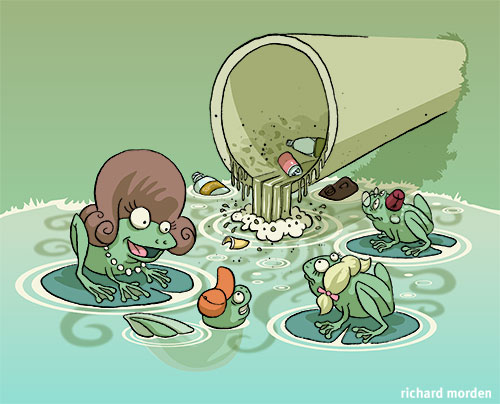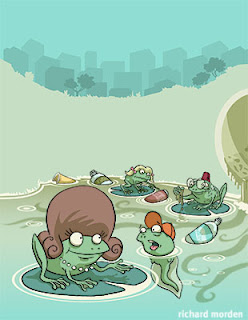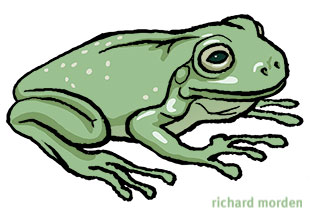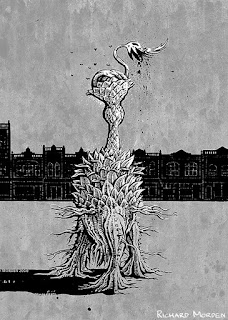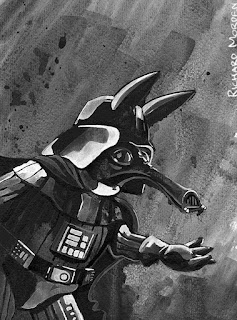A thorough step-by-step description
of how I print stencil art gift cards
People appreciate it when you hand make cards to give out for birthdays and Christmas time, but there just aren't enough hours in the day to make personalised cards for everybody. So as a happy compromise I hand print cards in batches.
Stencil art is simple, fun, inexpensive, and creates unique art with a lovely hand crafted finished result, so is a great print method to use for making cards. There are three parts to the process: making the stencil, preparing materials and surface for printing cards and printing the cards.
*WARNING* stencil art is addictive! Once you start painting it's hard to know when to stop. You might just start stencil painting every available surface at hand - wrapping paper, walls, pets, vehicles, family members, and so on.
What you will need to design and cut out a stencil
- a pencil
- paper to sketch on
- a design concept! - a star, a fish, a face, what-ever takes your fancy.
- some 'ezy cut stencil paper' and a ball point pen or acetate and a fine permanent marker
- a sharp craft knife or good scissors
- cutting mat
What you will need to print the stencil design onto gift cards
- your beautifully cut out stencil design
- nice thick card to print the design onto
- paint - acrylic dries quickly, which is good
- some water
- a sponge or rag to paint with
- a bench or table surface to print upon
- old news paper or large sheets of waste paper to protect the bench or table
- paper towel to keep things clean
- somewhere safe the cards can sit undisturbed while the paint dries
- envelopes for your cards
Designing and cutting out the stencil
Use the pencil and paper to sketch your design. It can be anything you like - a star, a word, a flower, a fish, a robot, a face, what ever you like. For my cards I designed a Christmas beetle, as it's a little seasonal without being religious or tacky.
Important! Make sure you don't design any 'islands'. For instance, if you are cutting out a stencil of the letter 'A' you can't cut out the entire outside shape and then leave the middle bit of the 'A' remaining, as the middle bit will just drop out. That's an island folks! Instead, join the centre shape to the outside shape with bridges. The same applies to all stencil images, not just letters. Have a go, you will see what I mean.
When you are happy with your design, trace it onto some ezy cut stencil paper with a ball point pen (or onto acetate with a permanent marker). Trace using a lightbox, or tape the design onto a window and use the outside light to trace. You want your stencil paper to be bigger than the card you are printing on to, so you don't get paint on your card where you don't want it.
Now with your stencil paper on the cutting mat, slowly and carefully cut following your traced design, turning the stencil paper around as you go to make the cutting easier. Be sure to cut the corners cleanly, don't just wrench out the almost-cut shape.
A simple shape will take only a couple of minutes to cut out, a complex one can take an hours - seriously!
So now you have your beautiful shape cut out of stencil paper (or acetate) and are ready to start printing.
Preparing to print your stencil design
There are a few things to prepare before you start printing.
Make sure you have your cards ready to print on. A5 sheets of thick paper work well as they fold in half to make A6 cards, a common size easy to find envelopes for (use C6 envelopes). To make the folding bit neater and easier I 'score' or put a crease in the cards where they should fold by running the edge of a tea spoon firmly along the edge of a ruler.
Put down some newspaper or scrap paper to protect the bench/table surface you will be working on.
If you want the print to be in exactly the same place on each card you need to draw a placement guide on scrap paper to help you position your card and stencil during the printing process. The technical term for this is print registration. On top of a large sheet of scrap paper, line up your stencil design on one of the cards exactly where you think it should go. Trace around the edges of the card and then the edges of the stencil paper. You will now have two overlapping rectangles drawn on your scrap paper. Use this as a guide and every print will be in the same place.
Put a big glob of paint on a palette. For paint I use acrylic, as it dries quickly. Fabric paint works well too and comes in sparkly colours! For a palette I use a plate covered with tin foil, making it easy to clean up when you are finished.
Dampen your sponge with water so it is soft and malleable, but squeeze out as much of the water as possible. You don't want the water in the sponge watering your paint down as it will run under the stencil paper when printing.
Put your first sheet of card in place, and lay the stencil design over the top. Get it all lined up to print.

Put a swipe of paint on your sponge and dabble it up and down a few times elsewhere on the palette, to spread the paint evenly on the sponge surface.
Printing your stencil design
Let the fun begin! Hold down the stencil design onto the card surface with one hand and, using the sponge in a rocking, padding motion, apply the paint through the stencil and onto the card. Don't push down on the sponge too hard as it will push paint under the edges of the cut stencil shape, creating nasty blobs where you don't want them - just pat the paint on. You will get the hang of this.
When you have filled the cut out area of the stencil design with sponged-on paint, put the sponge aside and gently peel off the stencil paper. There you go, your first print! Now simply repeat until all your cards are done.
During the printing process use the paper towel to keep at least one hand clean of paint, so you can handle printed cards, transferring them to your drying space without finger-pints. I use a clothes drying rack to peg my prints up - keeps them neatly in a small space and out of the way. If using acrylic paint your prints will probably only need about a day to dry.
Once the printed cards are dry remember to photograph your efforts! Photographs of repeating printed artworks always look cool.
Now you only have to fold the cards, write in them (the hardest part of the process) and post them to friends and family - who will all be utterly delighted to receive them.
As you can see I made two-colour cards. This meant I had to print one colour onto all the cards, let them dry and then print the next colour over the top and allow them to dry again. So setting up print registration and allowing lots of drying time was important.
I also used multiple paint colours on the sponge at the same time, allowing the paint to mix on the actual surface of the print - bit arty, eh?!
I also used multiple paint colours on the sponge at the same time, allowing the paint to mix on the actual surface of the print - bit arty, eh?!


Remember, this is just how I do it. Have a go, play and experiment, and see what works for you.
Feel free to send a card to me!
Feel free to send a card to me!
This has been my very first tutorial, so if you like it or even if you hate it please leave a comment and let me know. Thanks.
R :)





























